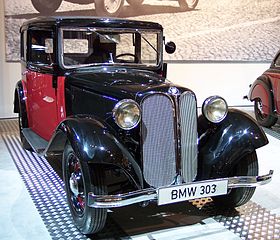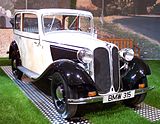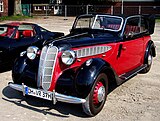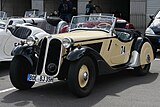
The BMW 328 was a sports car produced by BMW from 1936 to 1940. Its body design is credited to Peter Szymanowski, who became BMW chief of design after World War II.

The BMW M30 is a SOHC straight-six petrol engine which was produced from 1968 to 1995. With a production run of 27 years, it is BMW's longest produced engine and was used in many car models.

The BMW M54 is a naturally aspirated straight-6 DOHC petrol engine produced from 2000 to 2006. It was released in the E53 X5 and is the replacement for the M52 engine. The S54 is the equivalent high performance engine, used in the E46 M3, the Z3 M Coupé/Roadster and the E85/E86 Z4 M. The BMW M56 SULEV engine is based on the M54.

The BMW N62 is a naturally aspirated V8 petrol engine which was used in BMW cars from 2001–2010. It also remained in small-scale production for the Morgan Aero until 2019. The N62 is the world's first engine to use a continuously variable-length intake manifold, and BMW's first V8 to feature variable valve lift.

The BMW New Class was a line of sedans and coupes produced by German automaker BMW between 1962 and 1972. These models ensured BMW's solvency after the company's financial crisis of the 1950s and established the identity of BMW automobiles as sports sedans.
The BMW 3/15 was BMW's first car, produced in its first version as a "Dixi" between 1927 and 1929 and then, following BMW's acquisition of the Dixi business in October 1928, in three subsequent versions as BMWs from July 1929 till March 1932, when BMW gave up the licence under which the Austin designed cars were produced.
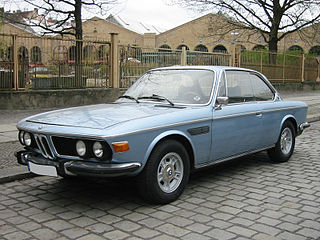
The BMW E9 is a range of coupés produced by German automaker BMW from 1968 to 1975. Initially released as the 2800 CS model, the E9 was based on the BMW 2000 C / 2000 CS four-cylinder coupés, which were enlarged to fit the BMW M30 six-cylinder engine. The E9 bodywork was built by Karmann.

The BMW 507 is a grand touring convertible that was produced by German automobile manufacturer BMW from 1956 until 1959. Initially intended to be exported to the United States at a rate of thousands per year, it ended up being too expensive, resulting in a total production figure of 252 cars and heavy financial losses for BMW.

The BMW 700 is a small rear-engined car which was produced by BMW in various models from August 1959 to November 1965. It was the first BMW automobile with a monocoque structure. The 700 was a sales success at a time when BMW was close to financial ruin. The 700 was also successful in its class in motorsport, both in its stock form and as the basis of a racing special called the 700RS.

The official founding date of the German motor vehicle manufacturer BMW is 7 March 1916, when an aircraft producer called Bayerische Flugzeugwerke was established. This company was renamed to Bayerische Motoren Werke (BMW) in 1922. However, the BMW name dates back to 1917, when Rapp Motorenwerke changed its name to Bayerische Motoren Werke. BMW's first product was a straight-six aircraft engine called the BMW IIIa. Following the end of World War I, BMW remained in business by producing motorcycle engines, farm equipment, household items and railway brakes.

The BMW 501 was a luxury car manufactured by BMW from 1952 to 1958. Introduced at the first Frankfurt Motor Show in 1951, the 501 was the first BMW model to be manufactured and sold after the Second World War, and as the first BMW car built in Bavaria. The 501 and its derivatives, including the V8 powered BMW 502, were nicknamed “Baroque Angels” by the German public. The BMW 502 was the first postwar German car to be manufactured with a V8 engine.

The BMW 503 is a two-door 2+2 gran turismo manufactured by German automaker BMW from 1956 until 1959. The company developed the 503, built in coupé and cabriolet body styles, alongside the 507 roadster. The 503 and 507 cost about twice their projected price and did not recover their development costs. During production from May 1956 to March 1959, 413 units of the 503 were built, 139 of which were Cabriolets. Despite being a prestige model, it resulted in heavy losses for BMW.

The BMW M78 is a petrol overhead valve straight-six engine which was produced from 1933 to 1950. It is the first straight-6 automobile engine produced by BMW, an engine layout which has been a key feature of the brand for many years since.
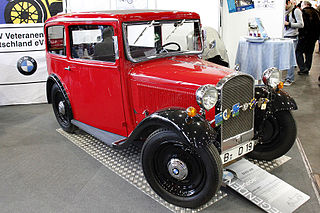
The BMW 3/20 PS was the first BMW automobile designed entirely by BMW. It was manufactured from 1932 to 1934, replacing the 3/15 model that was initially an Austin 7 manufactured under licence from the Austin Motor Company.

The BMW 320 was a car manufactured by BMW in Germany from 1937 to 1938, as the successor to the 319-based BMW 329. It was offered in 2 door saloon and convertible versions. Approximately 4,200 cars were made, of which 1,835 were cabriolets.
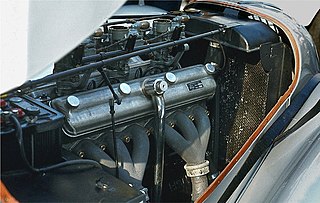
The BMW M328 is an overhead valve straight-six petrol internal combustion engine which was produced from 1936 to 1940. It was a high-performance development of the BMW M78 engine that was produced alongside the M78.

The BMW M337 is a straight-6 OHV petrol engine installed at a slanted angle which was produced in three variants from 1952-1958. Built to power BMW's first new car after World War II, the M337 engine was a replacement for the BMW M78.

The Opel 1,2 Liter is a small car manufactured by Opel between 1931 and 1935. The 1,2 Liter was replaced in 1935 by the Opel P4 which was broadly similar but employed a new engine and continued in production until December 1937. For just one year, in 1933, the manufacturer also offered the Opel 1,0 Liter which was a smaller engined version of the 1,2 Liter. The Opel 1,2 Liter replaced the last version of the Opel Laubfrosch and was itself first complemented and then effectively replaced by the more roomy Opel Kadett, which had itself already entered production in 1935.

The Škoda Popular is a small family car that was made in Czechoslovakia by Škoda from 1933 to 1946. It was the company's most affordable car at the time.

The Hanomag Rekord is a mid-size car produced by Hanomag in Hannover from 1933 until 1940. The car was Hanomag's first mid-size model and one of the first mass-produced cars available with a diesel engine. Hanomag introduced the Rekord as the 6/32 PS intermediate model in autumn of 1933; the first car to bear the Rekord name followed shortly thereafter in February 1934. Compared with the 6/32 PS, the Rekords have a longer wheelbase, independent front suspension and different engine ancillaries. In 1937, the vehicle was updated with a new "streamlined" back, and the production of the diesel engine model commenced – prior to 1937, all Rekords were fitted with an Otto engine. In total, Hanomag built 19,104 Rekords.
